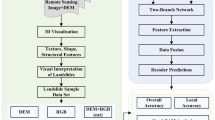Abstract
This paper proposes a red tide monitoring method based on clustering and modular neural networks. To obtain the features of red tide from a mass of aerial remote sensing hyperspectral data, first the Log Residual Correction (LRC) is used to normalize the data, and then clustering analysis is adopted to select and form the training samples for the neural networks. For rapid monitoring, the discriminator is composed of modular neural networks, whose structure and learning parameters are determined by an Adaptive Genetic Algorithm (AGA). The experiments showed that this method can monitor red tide rapidly and effectively.
Similar content being viewed by others
References
Cui, T. W., J. Zhang, Y. Ma, and X. M. Gao, 2003. Spectral characteristics analysis of red tide water in mesocosm experiment.SPIE Proc. Ocean Rem. Sensing Appl.,4892: 287–294.
Eiji, N., H. Hiroyuki, H. Taizo, N. Katsuyuki, H. Naotsuguet al., 2001. Prediction of occurrence of heterocapsa circularisquama red tide by means of fuzzy neural network.J. Chem. Eng. Jpn.,34 (8): 998–1005.
Fan, X. W., H. D. Zhang, and X. W. Sun, 2003. The application of hyper-spectral data to the detection and identification of red tides.Rem. Sensing Land Res.,1: 8–12.
Fan, X. W., and H. D. Zhang, 2002. Technique for obtaining the red tide species characteristic spectrum.Yellow Sea and Bohai Sea,20 (2): 83–90.
Ji, G. R., W. C. Zhao, and B. Qin, 2004.A Red Tide Monitoring Method of the Aerial Remote Sensing Hyperspectral Image. Asia-Pacific Radio Sci. Conf. Qingdao, China, 185–188.
Lu, B. L., Y. Bai, H. Kita, and Y. Nishikawa, 1994. A multi-sieving neural-networks architecture that decomposes learning tasks automatically. In:Proc. IEEE Conf. Neural Networks. Orlando, 1319–1324.
Ma, Y., 2003. The study on detecting technology of the red tide aerial remote sensing hyper-spectral.Chin. Acad. Sci., 35–38.
Tassan, S., 1993. An algorithm for the detection of the white-tide phenomenon in the Adriatic Sea using AVHRR data.Rem. Sensing Environ.,45: 29–42.
Wang, X. P., and L. M. Cao, 2002.Theory Application of GA and Software Realization. Publishing Company of Xi'an Jiao Tong University, Xi'an, 189–209.
Zhang, Z. G., and R. S. Wang, 2000. Image spectrometer remote sensing methodological technology and it's application based on spectroscopy.Rem. Sensing Land & Resour.,3: 16–24, 37.
Zhao, D. Z., 2000Collections of Evaluating and Monitoring Red Tides in Bohai of China. Ocean Press, Beijing, 117–120.
Zhao, Q. F, 1997. A study on co-evolutionary learning of neural networks.Proc. First Asia-Pacific Conf. Simulated Evol. Learn., Taejon, 287–294.
Author information
Authors and Affiliations
Corresponding author
Rights and permissions
About this article
Cite this article
Guangrong, J., Jie, S., Wencang, Z. et al. The monitoring of red tides based on modular neural networks using airborne hyperspectral remote sensing. J. Ocean Univ. China 5, 169–173 (2006). https://doi.org/10.1007/BF02919218
Received:
Accepted:
Issue Date:
DOI: https://doi.org/10.1007/BF02919218




